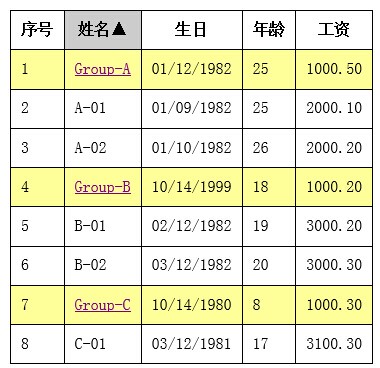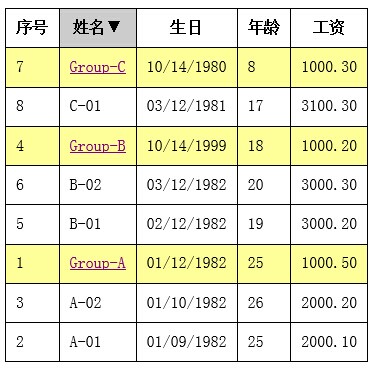 Web Front-end
Web Front-end
 JS Tutorial
JS Tutorial
 Example analysis of jQuery implementation of Table header sorting with grouped data_jquery
Example analysis of jQuery implementation of Table header sorting with grouped data_jquery
Example analysis of jQuery implementation of Table header sorting with grouped data_jquery
The example in this article describes how jQuery implements Table header sorting with grouped data. Share it with everyone for your reference, the details are as follows:
As shown below:


Requirement: When clicking on the table header to sort, the data hierarchical relationship between "Group" and "Group Details" remains unchanged
I found a regular table sorting from the Internet, modified it to meet the "group support", and posted it here for backup
<!DOCTYPE HTML PUBLIC "-//W3C//DTD XHTML 1.0 Transitional//EN"
"http://www.w3.org/TR/xhtml1/DTD/xhtml1-transitional.dtd">
<html xmlns="http://www.w3.org/1999/xhtml">
<head>
<meta http-equiv="Content-Type" content="text/html; charset=gb2312" />
<style type="text/css">
.tbl-list, .tbl-list td, .tbl-list th {
border: solid 1px #000;
border-collapse: collapse;
padding: 10px;
margin: 15px;
}
</style>
<script type="text/javascript" src="jquery.min.js"></script>
<title>table sort</title>
<script type="text/javascript">
//排序 tableId: 表的id,iCol:第几列 ;dataType:iCol对应的列显示数据的数据类型
function sortAble(th, tableId, iCol, dataType) {
var ascChar = "▲";
var descChar = "▼";
var table = document.getElementById(tableId);
//排序标题加背景色
for (var t = 0; t < table.tHead.rows[0].cells.length; t++) {
var th = $(table.tHead.rows[0].cells[t]);
var thText = th.html().replace(ascChar, "").replace(descChar, "");
if (t == iCol) {
th.css("background-color", "#ccc");
}
else {
th.css("background-color", "#fff");
th.html(thText);
}
}
var tbody = table.tBodies[0];
var colRows = tbody.rows;
var aTrs = new Array;
//将得到的行放入数组,备用
for (var i = 0; i < colRows.length; i++) {
//注:如果要求“分组明细不参与排序”,把下面的注释去掉即可
//if ($(colRows[i]).attr("group") != undefined) {
aTrs.push(colRows[i]);
//}
}
//判断上一次排列的列和现在需要排列的是否同一个。
var thCol = $(table.tHead.rows[0].cells[iCol]);
if (table.sortCol == iCol) {
aTrs.reverse();
} else {
//如果不是同一列,使用数组的sort方法,传进排序函数
aTrs.sort(compareEle(iCol, dataType));
}
var oFragment = document.createDocumentFragment();
for (var i = 0; i < aTrs.length; i++) {
oFragment.appendChild(aTrs[i]);
}
tbody.appendChild(oFragment);
//记录最后一次排序的列索引
table.sortCol = iCol;
//给排序标题加“升序、降序” 小图标显示
var th = $(table.tHead.rows[0].cells[iCol]);
if (th.html().indexOf(ascChar) == -1 && th.html().indexOf(descChar) == -1) {
th.html(th.html() + ascChar);
}
else if (th.html().indexOf(ascChar) != -1) {
th.html(th.html().replace(ascChar, descChar));
}
else if (th.html().indexOf(descChar) != -1) {
th.html(th.html().replace(descChar, ascChar));
}
//重新整理分组
var subRows = $("#" + tableId + " tr[parent]");
for (var t = subRows.length - 1; t >= 0 ; t--) {
var parent = $("#" + tableId + " tr[group='" + $(subRows[t]).attr("parent") + "']");
parent.after($(subRows[t]));
}
}
//将列的类型转化成相应的可以排列的数据类型
function convert(sValue, dataType) {
switch (dataType) {
case "int":
return parseInt(sValue, 10);
case "float":
return parseFloat(sValue);
case "date":
return new Date(Date.parse(sValue));
case "string":
default:
return sValue.toString();
}
}
//排序函数,iCol表示列索引,dataType表示该列的数据类型
function compareEle(iCol, dataType) {
return function (oTR1, oTR2) {
var vValue1 = convert(removeHtmlTag($(oTR1.cells[iCol]).html()), dataType);
var vValue2 = convert(removeHtmlTag($(oTR2.cells[iCol]).html()), dataType);
if (vValue1 < vValue2) {
return -1;
}
else {
return 1;
}
};
}
//去掉html标签
function removeHtmlTag(html) {
return html.replace(/<[^>]+>/g, "");
}
//jQuery加载完以后,分组行高亮背景,分组明细隐藏
$(document).ready(function () {
$("tr[group]").css("background-color", "#ff9");
$("tr[parent]").hide();
});
//点击分组行时,切换分组明细的显示/隐藏
function showSub(a) {
var groupValue = $(a).parent().parent().attr("group");
var subDetails = $("tr[parent='" + groupValue + "']");
subDetails.toggle();
}
</script>
</head>
<body>
<table id="tableId" class="tbl-list" cellpadding="0" cellspacing="0">
<thead>
<tr>
<th>序号</th>
<th onclick="sortAble(this,'tableId', 1,'string')"
style="cursor:pointer">姓名</th>
<th onclick="sortAble(this,'tableId', 2, 'date')"
style="cursor:pointer">生日</th>
<th onclick="sortAble(this,'tableId', 3, 'int')"
style="cursor:pointer">年龄</th>
<th onclick="sortAble(this,'tableId', 4, 'float')"
style="cursor:pointer">工资</th>
</tr>
</thead>
<tbody>
<tr group="A">
<td>1</td>
<td><a href="#" onclick="showSub(this)">Group-A</a></td>
<td>01/12/1982</td>
<td>25</td>
<td>1000.50</td>
</tr>
<tr parent="A">
<td>2</td>
<td>A-01</td>
<td>01/09/1982</td>
<td>25</td>
<td>2000.10</td>
</tr>
<tr parent="A">
<td>3</td>
<td>A-02</td>
<td>01/10/1982</td>
<td>26</td>
<td>2000.20</td>
</tr>
<tr group="B">
<td>4</td>
<td><a href="#" onclick="showSub(this)">Group-B</a></td>
<td>10/14/1999</td>
<td>18</td>
<td>1000.20</td>
</tr>
<tr parent="B">
<td>5</td>
<td>B-01</td>
<td>02/12/1982</td>
<td>19</td>
<td>3000.20</td>
</tr>
<tr parent="B">
<td>6</td>
<td>B-02</td>
<td>03/12/1982</td>
<td>20</td>
<td>3000.30</td>
</tr>
<tr group="C">
<td>7</td>
<td><a href="#" onclick="showSub(this)">Group-C</a></td>
<td>10/14/1980</td>
<td>8</td>
<td>1000.30</td>
</tr>
<tr parent="C">
<td>8</td>
<td>C-01</td>
<td>03/12/1981</td>
<td>17</td>
<td>3100.30</td>
</tr>
</tbody>
</table>
</body>
</html>I hope this article will be helpful to everyone in jQuery programming.

Hot AI Tools

Undresser.AI Undress
AI-powered app for creating realistic nude photos

AI Clothes Remover
Online AI tool for removing clothes from photos.

Undress AI Tool
Undress images for free

Clothoff.io
AI clothes remover

Video Face Swap
Swap faces in any video effortlessly with our completely free AI face swap tool!

Hot Article

Hot Tools

Notepad++7.3.1
Easy-to-use and free code editor

SublimeText3 Chinese version
Chinese version, very easy to use

Zend Studio 13.0.1
Powerful PHP integrated development environment

Dreamweaver CS6
Visual web development tools

SublimeText3 Mac version
God-level code editing software (SublimeText3)

Hot Topics
 Detailed explanation of jQuery reference methods: Quick start guide
Feb 27, 2024 pm 06:45 PM
Detailed explanation of jQuery reference methods: Quick start guide
Feb 27, 2024 pm 06:45 PM
Detailed explanation of jQuery reference method: Quick start guide jQuery is a popular JavaScript library that is widely used in website development. It simplifies JavaScript programming and provides developers with rich functions and features. This article will introduce jQuery's reference method in detail and provide specific code examples to help readers get started quickly. Introducing jQuery First, we need to introduce the jQuery library into the HTML file. It can be introduced through a CDN link or downloaded
 How to use PUT request method in jQuery?
Feb 28, 2024 pm 03:12 PM
How to use PUT request method in jQuery?
Feb 28, 2024 pm 03:12 PM
How to use PUT request method in jQuery? In jQuery, the method of sending a PUT request is similar to sending other types of requests, but you need to pay attention to some details and parameter settings. PUT requests are typically used to update resources, such as updating data in a database or updating files on the server. The following is a specific code example using the PUT request method in jQuery. First, make sure you include the jQuery library file, then you can send a PUT request via: $.ajax({u
 In-depth analysis: jQuery's advantages and disadvantages
Feb 27, 2024 pm 05:18 PM
In-depth analysis: jQuery's advantages and disadvantages
Feb 27, 2024 pm 05:18 PM
jQuery is a fast, small, feature-rich JavaScript library widely used in front-end development. Since its release in 2006, jQuery has become one of the tools of choice for many developers, but in practical applications, it also has some advantages and disadvantages. This article will deeply analyze the advantages and disadvantages of jQuery and illustrate it with specific code examples. Advantages: 1. Concise syntax jQuery's syntax design is concise and clear, which can greatly improve the readability and writing efficiency of the code. for example,
 How to remove the height attribute of an element with jQuery?
Feb 28, 2024 am 08:39 AM
How to remove the height attribute of an element with jQuery?
Feb 28, 2024 am 08:39 AM
How to remove the height attribute of an element with jQuery? In front-end development, we often encounter the need to manipulate the height attributes of elements. Sometimes, we may need to dynamically change the height of an element, and sometimes we need to remove the height attribute of an element. This article will introduce how to use jQuery to remove the height attribute of an element and provide specific code examples. Before using jQuery to operate the height attribute, we first need to understand the height attribute in CSS. The height attribute is used to set the height of an element
 jQuery Tips: Quickly modify the text of all a tags on the page
Feb 28, 2024 pm 09:06 PM
jQuery Tips: Quickly modify the text of all a tags on the page
Feb 28, 2024 pm 09:06 PM
Title: jQuery Tips: Quickly modify the text of all a tags on the page In web development, we often need to modify and operate elements on the page. When using jQuery, sometimes you need to modify the text content of all a tags in the page at once, which can save time and energy. The following will introduce how to use jQuery to quickly modify the text of all a tags on the page, and give specific code examples. First, we need to introduce the jQuery library file and ensure that the following code is introduced into the page: <
 Use jQuery to modify the text content of all a tags
Feb 28, 2024 pm 05:42 PM
Use jQuery to modify the text content of all a tags
Feb 28, 2024 pm 05:42 PM
Title: Use jQuery to modify the text content of all a tags. jQuery is a popular JavaScript library that is widely used to handle DOM operations. In web development, we often encounter the need to modify the text content of the link tag (a tag) on the page. This article will explain how to use jQuery to achieve this goal, and provide specific code examples. First, we need to introduce the jQuery library into the page. Add the following code in the HTML file:
 Understand the role and application scenarios of eq in jQuery
Feb 28, 2024 pm 01:15 PM
Understand the role and application scenarios of eq in jQuery
Feb 28, 2024 pm 01:15 PM
jQuery is a popular JavaScript library that is widely used to handle DOM manipulation and event handling in web pages. In jQuery, the eq() method is used to select elements at a specified index position. The specific usage and application scenarios are as follows. In jQuery, the eq() method selects the element at a specified index position. Index positions start counting from 0, i.e. the index of the first element is 0, the index of the second element is 1, and so on. The syntax of the eq() method is as follows: $("s
 How to tell if a jQuery element has a specific attribute?
Feb 29, 2024 am 09:03 AM
How to tell if a jQuery element has a specific attribute?
Feb 29, 2024 am 09:03 AM
How to tell if a jQuery element has a specific attribute? When using jQuery to operate DOM elements, you often encounter situations where you need to determine whether an element has a specific attribute. In this case, we can easily implement this function with the help of the methods provided by jQuery. The following will introduce two commonly used methods to determine whether a jQuery element has specific attributes, and attach specific code examples. Method 1: Use the attr() method and typeof operator // to determine whether the element has a specific attribute





